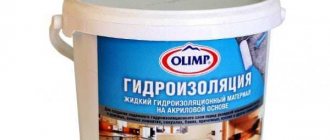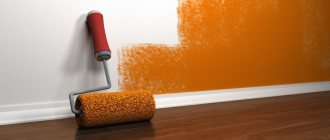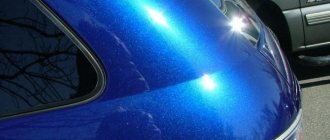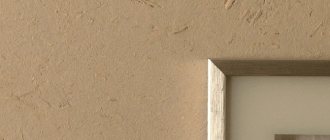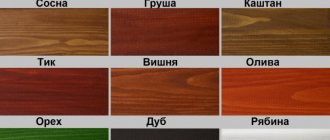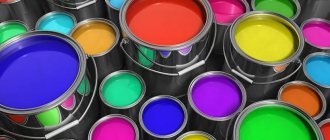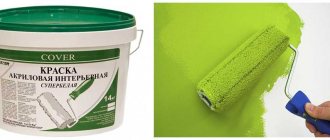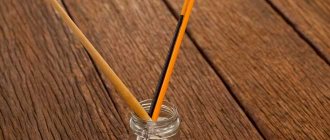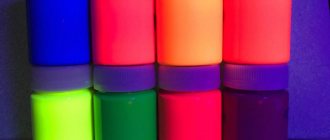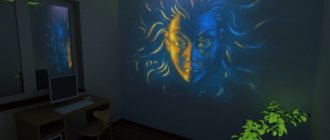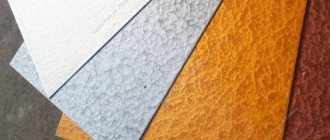Why do these coatings glow?
A special pigment provides the glow of fluorescent paint; The fluorophore converts and transmits the ultraviolet rays it absorbs into the visible part of the spectrum.
Fluorophores are usually represented by substances such as rhodamines, as well as aminonaphthalimide derivatives. Since these components are too expensive in their pure form, they paint the smallest particles of a polymer dispersion, obtaining that special, fluorescent pigment that is added to the base of the material during paint production.
Such a coating is not capable of absorbing and storing light, unlike luminescent paints that glow in the dark without any external influence. They contain another active substance - a phosphor, and these paints are otherwise called neon. Fluorescents only reflect the rays of the sun or the light of ultraviolet lamps.
How is it different from fluorescent
Fluorescence is classified as a type of luminescence. The differences relate to how long the light is released. Phosphors are capable of glowing in the dark for 8-12 hours, without requiring additional energy recharge. Accumulation occurs during the day, while at night the coating only emits light.
Fluorescent compounds are directly dependent on exposure to ultraviolet rays. In this case, intense exposure to sunlight leads to pigment fading and a decrease in the brightness of the glow. They do not so much glow themselves as they reflect the UV spectrum.
Fluorescent paint is an extremely effective and bright coating, the use of which allows you to get an impressive result. Understanding the features of such paints will protect you from surprises and help you achieve your goals in interior design or other areas in the shortest possible time.
Areas of use
Modern man almost every day observes a large number of objects with a fluorescent coating.
Outside the home
- road markings, signs and markers, parking lots and runways;
- signs for cafes and shops;
- billboards;
- building facades with lighting and appropriate finishing, stained glass;
- graffiti;
- airbrushing on cars, inscriptions on special-purpose vehicles;
- interior design of nightclubs and restaurants.
At home
- finishing of walls and multi-level ceilings in bedrooms;
- creating a fabulous atmosphere in children's rooms;
- restoration and stylization of outdated pieces of furniture.
If an artist is involved in applying the luminous pattern, then the apartment will literally sparkle with new colors, completely transforming in the evening and at night. However, you can add a few simple elements to the interior using luminous compounds yourself.
DIY reflective paint can also be made, and this is another option to get light in the dark
Handmade
- panels or paintings,
- Christmas tree decorations and garlands,
- figurines, dolls, keychains, etc.
Body painting
- Temporary tatoos,
- body art,
- face painting
This type of painting is used as entertainment at children's parties and attractions, as well as at stylized parties or masquerades. To work on the body, a special composition of glycerin, lanolin and fluorescent pigment mixed with water is used.
Important: before applying paint to the body, it is necessary to conduct an allergy test by making a small smear on the inner elbow and wait about half an hour. If there is no reaction in the form of itching or redness, then you can begin to create the main drawing.
This composition can be easily washed off using body scrub products or warm water and soap.
Other Applications
- in the textile industry to create ornaments or images on clothing items;
- for illuminating living plants during night events;
- in show business and film industry.
And this is not the entire list.
Luminous, reflective and fluorescent paints
Rating 4.50 (7 Votes)
| Glow in the dark, shine and reflect light - modern paint coatings can do all this. In addition to interesting visual effects, such paints perform important functions of visibility and safety in many areas of our lives. This article will tell you what paints with luminous effects are, what their differences are and what they are used for. |
Paints with a glow effect can be divided into: 1 Luminescent (phosphorescent) paints - accumulate light energy from the sun or other bright light sources and, when darkness sets in, softly release the accumulated light, glowing “on their own.” These paints contain a phosphor. The glow time of luminescent paint without additional illumination can reach 12 hours! 2 Reflective (reflective) paints and varnishes - glow when directly hit by light rays. In complete darkness, such paints do not glow, but, thanks to the special particles included in the composition, they well reflect the light directed at the treated surface. 3 Fluorescent paints acquire a bright neon hue under ultraviolet rays, but do not glow in complete darkness.
Acrylic, alkyds, polyurethane and other substances are used as paint bases. Acrylic paints are universal and suitable for many surfaces: wood, plastic, metal, fabric, etc. Due to their wear resistance, acrylic paints are suitable not only for arts and crafts, but also for exterior finishing work. Alkyd paints are suitable for metal, wood, stone, and are used more often for interior finishing work.
| Luminescent and phosphorescent paints are produced by many manufacturers: Decorix, Bosny, G-Color, Kudo, Rust-Oleum, Montana. In daylight, the colors have a delicate blue, green or purple tint, and in the dark, the glow enhances the colors, making them much brighter. If you need paint that will glow at night but remain completely invisible during the day, then you should pay attention to paints such as G-Color Glow Invisible, Phosphorescent Glow-in-Dark from Bosny, luminescent NightGlow Montana and Specialty Glow In The Dark from Rust -Oleum. |
Paints in aerosol cans will be very convenient for drawings and inscriptions on a large surface, and for decorating using a stencil. To paint small objects, you can choose luminescent paints in jars and bottles, for example, Love2art glow-in-the-dark paints, which can be easily applied with a brush to any surface.
| In addition to aerosols and bottles, markers with special inks that have all the properties of glowing in the dark and reflecting UV rays are a convenient format. Markers are suitable for small jobs that require neat, fine lines. In this category we can note the glowing markers Uni Chalk and Sakura Glow-in-the-dark. Compositions with luminescent particles can also be used for drawing on fabric. Glow-in-the-dark designs can be applied to fabric with special paints designed for textiles, such as Fabric Design from Lilack. Luminescent fabric paint does not require fixing, and the applied pattern will withstand gentle washing, maintaining its luminous properties. |
Reflective
The effect is achieved by compositions in which special particles are added that reflect the light falling on them, thereby identifying an object in the dark. As a rule, these are transparent, colorless or lightly tinted varnishes that can be applied to a surface with a pattern or inscription.
| Reflective paints are most often used to mark objects and objects that need to be visible in the dark, for example, in the light of headlights. These are road signs, temporary road barriers, reflective elements on cars, motorcycles and motorcycle helmets. Parts of baby strollers and children's outerwear, bicycles, scooters are treated with special compounds. All this is done to ensure the safety of drivers and pedestrians: the light of car headlights is bright enough to be reflected even from small parts. |
Most often, a transparent varnish with reflective mirror particles is used. For example, Bosny Light Reflector and Specialty Reflective paint-varnish from Rust-Oleum. This coating allows you to see an object illuminated by headlights, without exposing it, leaving all the original colors. Reflective varnish is very weather resistant, making it an excellent product for outdoor use. Colored opaque paints can also have some reflective effect; a series of such paints is represented by the Kudo brand. Fluorescent
paints are used mainly for decorative purposes; they have bright, intense colors that are clearly visible during the day, and in the dark under ultraviolet rays they acquire a special shade of color, as if glowing with neon. Fluorescent paints for decorative and protective painting are produced by many manufacturers: Bosny, Decorix, Belton, Kudo, MTN and many others.
Application of paints with luminous effects
Before painting, the surface is cleaned, degreased, and, if necessary, primed (preferably with white or light primer). This will improve the adhesion of the paint to the base and increase the effect. Before application, the paint is thoroughly mixed for better and uniform distribution of pigments, and the can is shaken vigorously for several tens of seconds. Next, painting is done in the same way as with any other paints: with a brush, roller, sponge, spray gun. It is not recommended to coat the painted surface with varnish, as the luminous properties of the paint may deteriorate or disappear altogether.
| By decorating with luminous and reflective paints, you can create amazing visual effects that will reveal themselves in a new way in the dark. Luminescent accents will create local illumination of individual objects, transforming the children's room into a magical castle at nightfall, and transforming the dance floor into a spaceship. Marking bicycles and scooters will help them become visible at night and make movement safer. All this can be done with your own hands, using different paints with glowing effects. |
Visitors to this page most often choose from the online store:
| Varnish-paint with light diffusion effect Bosny | Luminescent paint MONTANA |
Types of luminous paints
Fluorescent paints vary in composition and purpose. The materials can be divided into three groups.
Acrylic composition for interior work
Fluorescent acrylic paint for interior decoration has the following advantages:
- you can mix materials of several colors to create the desired shade;
- the composition has no unpleasant odor and is absolutely non-toxic;
- the coating is suitable for wooden and plastered surfaces, fits well on drywall.
Flaws:
- low moisture resistance,
- Not suitable for painting metal and plastic surfaces.
These compositions are ideal for the walls of a bedroom or living room, but renovations in the bathroom are best done using other means.
Facade acrylic paints
The use of acrylic fluorescent paints for facade work is a wonderful way to give a building a festive and solemn look, especially since these materials have excellent quality characteristics:
- increased resistance to temperature changes,
- moisture resistance;
- abrasion resistance;
- high vapor permeability, no odor;
- good adhesion to almost any type of surface, including plastic, galvanized metal, concrete and others;
- The coating is not afraid of treatment with detergents.
If the material is purchased to create a light picture on the wall, then before starting work it is usually diluted with water.
Universal compositions based on urethane-alkyd
Aerosol paints in cans are used on various surfaces, and even on glass. The coating is very resistant to the negative effects of external factors. Those who do airbrushing for cars work with these paints. If someone dreams of a fluorescent bathroom or toilet with luminous designs, then spray paints are the most suitable option.
“Invisible” paints
Invisible fluorescent paint is practically unnoticeable in daylight on light surfaces, but on dark ones it can be detected in the form of whitish stains. This material is used both for the execution of unusual design solutions and for night illumination of road signs.
Invisible paint, paradoxically, has a rich color palette. Walls or ceilings, completely ordinary during the day, are magically transformed in the evening or at night: in the ultraviolet light of the lamps, intricate ornaments or romantic landscapes appear on their surfaces.
“Visible” paints during the day are practically no different from other paints and varnishes, since their glow also becomes noticeable only under ultraviolet rays against a background of darkness or twilight.
Application of fluorescent paint
Fluorescent paint in interior design
Paint with a fluorescent effect is widely used in various fields of activity:
- An excellent solution for outdoor advertising. When exposed to daylight, it stands out favorably and attracts attention against the background of any other surrounding color. At night, with the help of ultraviolet lamps, it acquires a bright glow in the dark.
- Used for original design solutions in entertainment centers, clubs, cafes.
- For marking fences, parking lots, and runways.
- For artwork, painting, children's creativity.
- For body painting (face painting, temporary tattoo).
- For inscriptions on special vehicles and rolling stock.
- In modeling and modding.
- For creating paintings with a fluorescent effect on concrete walls, stones, tiles. Creation of stained glass and drawings on glass and ceramics.
- To paint metal elements of a car body, wheels, use aerosol paint in cans.
- In the textile industry for dyeing fabrics, creating images and photos on T-shirts.
- Fluorescent stamp ink for applying invisible marks to cardboard and paper.
- The fluorescence effect is used in the manufacture of banknotes to protect against counterfeiting. If you illuminate such a banknote with an ultraviolet lamp, you can see signs that are invisible in normal light.
General disadvantages
- Unfortunately, coatings cannot fluoresce forever, since they have rather poor resistance to direct sunlight. You can avoid rapid fading by using protective agents, such as clear varnishes. When purchasing such a composition, it is important to make sure that it does not have matting properties, which will significantly reduce the glow effect.
- The texture of the fluorescent dispersion does not allow achieving a glossy surface finish. When such a need arises, you can resort to the method described in the previous paragraph.
- The material does not belong to heat-resistant compounds. Destroys at a temperature of +100-150 °C.
How to make it yourself
To create glowing paint, you need to mix just two components:
- clear acrylic varnish;
- fluorescent pigment in powder form, which can be purchased in a specialty store or online.
It is advisable to immediately select the second ingredient by color - the colorless polymer pigment largely loses its fluorescent properties when tinted.
Take one part of powder for four parts of varnish, mix the composition thoroughly, and after that you can begin the painting process.
Coloring
In application, fluorescent acrylic paints are practically no different from similar compositions without a “magic” pigment. If we are not talking about an aerosol, then the following tools will be required:
- brushes,
- paint roller,
- tray,
- You can also use a spray gun.
Fluorescent dyes are usually applied in two layers. The more layers, the brighter the glow effect will be. The time interval between staining should be at least three hours. Complete drying occurs within a day.
The coloring agent must be stored in a tightly closed container, so the best option for long-term storage is paint in cans.
Variety of species
Depending on the composition, there are several types of such dyes:
Perhaps the most popular luminous compositions are acrylic-based paints. They contain a fluorescent pigment and a binding component – acrylic. These dyes are used to decorate the interior of apartments and other premises.
A distinctive feature of acrylic paints is a wide palette of colors and shades. You can adjust the color saturation yourself by adding more or less color to the paint. This mixture can be used to paint the surface of drywall, wood, and plaster. But experts do not recommend using acrylic dyes for metal and plastic products.
Thus, Decola water-based acrylic paints are an artistic material for decoration. Designed for coloring paper, cardboard, wood, leather, canvas. The palette consists of 8 shades. You can purchase such coatings in the Leonardo online store.
Acrylic-based fluorescent paint in Monarca spray cans is suitable for both interior and exterior work. It can be used to paint metal, wood, glass, stone, plastic. Dries very quickly, has high adhesion, a large selection of shades.
The Nanza online store offers a huge selection of glowing paints. All these dyes are absolutely environmentally friendly and safe for health. Among the most popular colors are yellow, blue, red, orange, white, green.
Today, acrylic-based dyes are widely used for body art. Glowing patterns on the human body look unusual and fascinating. This design of the human body can very often be found at entertainment events, shows and performances. It is worth saying that thanks to the water-dispersed base, acrylic paints are absolutely harmless to the skin and health in general. They are also often used for tattoos. Young people also use luminous hair dyes.
Acrylic facade dyes are used to decorate walls and surfaces outside the building. They, accordingly, have the characteristics necessary for such conditions: coating strength, resistance to environmental factors. Namely: such a surface is not afraid of water and moisture, and withstands mechanical loads and friction. But at the same time, it is characterized by good vapor permeability, that is, the surface seems to breathe, which prevents the appearance of mold and mildew
This type of paint and varnish is used for treating walls made of brick and concrete, as well as for metal and plastic surfaces. Can also be used indoors with high humidity: in bathrooms, swimming pools.
Alkyd aerosol dyes are distinguished by their versatility. They have excellent characteristics and a wide range of applications. In addition to drywall, brick and plaster, they are even suitable for painting metal, plastic, wood and glass surfaces.
Decoration with fluorescent paints
